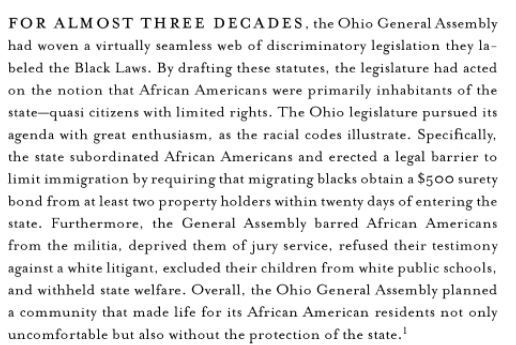Middleton explains general circumstances of Black people in 1830s Ohio.
- Type
- Book
- Source
- Stephen Middleton Non-LDS
- Hearsay
- DirectSecondary
- Reference
Stephen Middleton, The Black Laws: Race and the Legal Process in Early Ohio (Athens, OH: Ohio University Press, 2005), 74
- Scribe/Publisher
- Ohio University Press
- People
- Stephen Middleton
- Audience
- Reading Public
- Transcription
For almost three decades, the Ohio General Assembly had woven a virtually seamless web of discriminatory legislation they labeled the Black Laws. By drafting these statutes, the legislature had acted on the notion that African Americans were primarily inhabitants of the state--quasi citizens with limited rights. The Ohio legislature pursued its agenda with great enthusiasm, as the racial codes illustrate. Specifically, the state subordinated African Americans and erected a legal barrier to limit immigration by requiring that migrating blacks obtain a $500 surety bond from at least two property holders within twenty days of entering the state. Furthermore, the General Assembly barred African Americans from the militia, deprived them of jury service, refused their testimony against a white litigant, excluded their children from white public schools, and withheld state welfare. Overall, the Ohio General Assembly planned a community that made life for its African American residents not only uncomfortable but also without the protection of the state.
- Citations in Mormonr Qnas
The B. H. Roberts Foundation is not owned by, operated by, or affiliated with the Church of Jesus Christ of Latter-day Saints.

